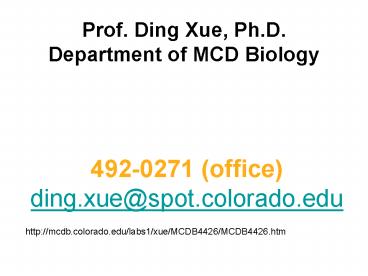Prof' Ding Xue, Ph'D' Department of MCD Biology - PowerPoint PPT Presentation
1 / 16
Title:
Prof' Ding Xue, Ph'D' Department of MCD Biology
Description:
Cell signaling and Animal development-- General introduction of cell-cell ... Cells secrete neurotransmitters at specialized junctions called chemical ... – PowerPoint PPT presentation
Number of Views:35
Avg rating:3.0/5.0
Title: Prof' Ding Xue, Ph'D' Department of MCD Biology
1
Prof. Ding Xue, Ph.D. Department of MCD Biology
492-0271 (office) ding.xue_at_spot.colorado.edu
http//mcdb.colorado.edu/labs1/xue/MCDB4426/MCDB44
26.htm
2
Why are you taking this class?
- Just for fun
- To get easy credits
- To learn how to read and think about science
- This might be a less boring class
- None of above
3
What is this class?
A different class, how science is created and
done!
Combination of many fields and several model
organisms
Your expectation of me?
Mostly paper discussions with a few lectures.
We will be very informal. Our job is to teach
and encourage you to think and to ask about
Science
My expectation of you
Read Learn Think Ask
4
Requirement
- cell biology, biochemistry, genetics, maybe
developmental biology - has time to read
- interested in thinking
- not to be too interested in grades as a senior
- I will not be traditional grader. Effort is 1,
activity and participation are what I am looking
for. - i-clicker system will be used in discussions and
answering questions.
5
Teaching contents
- Cell signaling and Animal development-- General
introduction of cell-cell signaling and the
development of model organisms - Signaling molecules in cell growth and
differentiation-- Signals, Receptors, and others - Signaling pathways in the development of model
organisms - Signaling in Apoptosis/Programmed cell death
6
Grading system
- Two exams (in class) (50)
- Paper discussion and participation in classroom
discussion (40) - Attendance (10).
- Grading in participation and discussion will
emphasize whether you have read the papers
thoroughly so that you can explain the figures
and tables well and your willingness to discuss
them more than the clarity of how you present and
discuss information. In other words, my emphasis
is on getting you to think about, criticize,
interpret, and discuss scientific experiments
without being intimidated about speaking up.
7
What is cell signaling?
- Mechanisms that one cell uses to communicate and
influence the behavior of another cell. - In a broader sense, the signaling could include
environmental cues received by a cell - Smell
- Light
- Mechanic pressure
- Heat
- A biological molecule
- Others
8
Three ways in which cells communicate with one
another
Slow, less specific But can signal to multiple
cells Signaling strength is distance-dependent
Faster, very specific But only affect few cells
Very fast, very specific Also affect few cells
9
Three strategies of cell signaling by secreted
molecules
1) Endocrine
2) Paracrine
10
3) Synaptic signaling
Nervous system. Cells secrete neurotransmitters
at specialized junctions called chemical
synapses the neurotransmitter diffuses across
the synaptic cleft, typically a distance of about
50 nm, and acts only on the adjacent
post-synaptic target cell.
11
Comparison of endocrine and synaptic signaling
Very Fast
Slow (minutes)
Precise
Specificity depend on ligands and receptors
Not Diluted
Diluted in the blood
12
The biochemistry of the cell signaling
- The nature of the signal
- A. Environmental cues
- light, chemicals, mechanical pressure,
pheromones, food and heat etc. - B. Cellular signals
- chemicals (Ions), hormones, peptides, lipid,
growth factors, membrane bound ligand, and gas
(NO and CO). - - hydrophilic signals can not diffuse to a cell
and signal by binding to cell surface receptor - - hydrophobic signals carried by carrier
protein in the blood and enter cells
13
Receptors (the molecule that receives the signal)
1) Ion channel-linked receptors
2) G-protein-linked seven transmembrane receptors
3) Enzyme-linked receptors
-receptor protein kinases tyrosine kinases,
serine/thronine kinases -receptors coupled to
protein kinases -protein tyrosine phosphatase
receptors
14
4) Intracellular ReceptorsSteroid hormone
receptors
15
THE DECISION OF LIFE VS. DEATH
16
Which of the followings has the faster signaling
speed?
- Endocrine signaling
- Synaptic signaling
- Signaling by steroid hormone receptors
- Signaling by paracrine
- All have similar speeds































